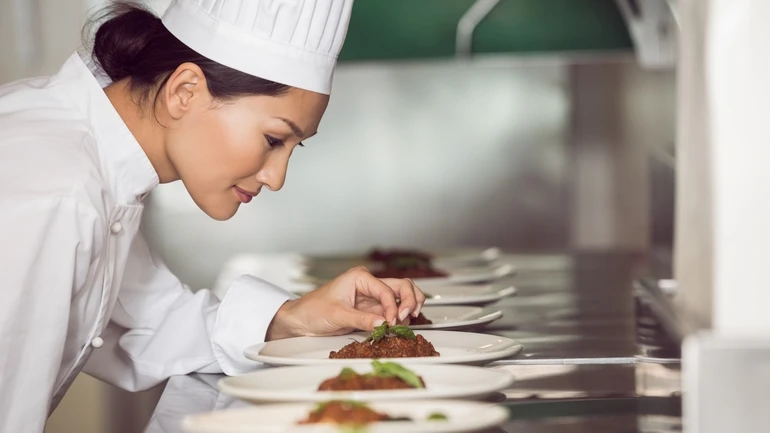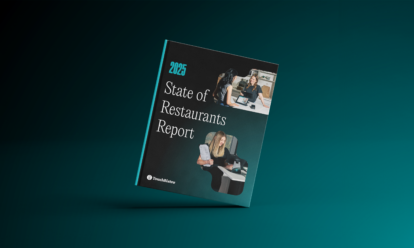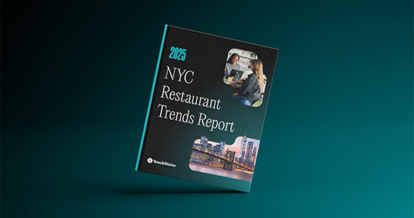You have a big vision for your restaurant. You’ve worked hard to create a strong brand and an atmosphere your guests love, but you know the real showstopper is your outstanding food. It’s time to put your restaurant on the map – that is, inside the coveted Michelin Guide. To do that, you first need to learn everything you can about how to get a Michelin Star.
Have you ever wondered, “How do restaurants get Michelin Stars?” In this comprehensive guide, we’ll cover:
- A definition and history of this culinary designation
- How Michelin Stars work and how hard it is to get one
- 5 criteria for landing your very own Michelin Star
- What happens after you get a Michelin Star (and whether you can lose it)
Buckle up, because your next stop is the pinnacle of culinary excellence.
What is a Michelin Star?
A Michelin Star is an international award given to fine dining restaurants for culinary excellence, based on five criteria. It is recognized as the food and beverage industry’s highest honor. Restaurants that have been awarded Michelin Stars are listed in the Michelin Guide, a renowned culinary publication.
The History of the Michelin Star
The Michelin Star ranking system was started by the Michelin tire company, founded by brothers Andre and Edouard Michelin in France in 1889. Cars were not commonplace in the country at the time, and neither were tires. So, to boost the popularity of cars – and therefore, rev up tire sales – the Michelin brothers created the Michelin Guide.
The Michelin Guide began as a travel publication intended to encourage people to explore by car. But by 1920, the guide began to take on a new raison d’etre.
“For the first time, it included a list of hotels in Paris [and] lists of restaurants according to specific categories,” states Michelin. “Acknowledging the growing influence of the guide’s restaurant section, the Michelin brothers also recruited a team of mystery diners – or restaurant inspectors, as we know them today – to visit and review restaurants anonymously.”
The Michelin Star itself emerged on the culinary scene in 1926 when the Michelin Guide started awarding stars to fine dining restaurants. In the beginning, no ranking system existed and restaurants could only receive one star. But that changed five years later when Michelin created a tiered ranking system that enabled restaurants to receive zero, one, two, or three stars.
Today, over 30 million Michelin Guides have been sold around the globe. The tiered Michelin Star system is still in use, and eligible chefs across three continents have their sights set on the stars.
The guide has also begun expanding to new cities like Toronto, where restaurants like Alo and Edulis – both TouchBistro customers! – have topped the list.
Will your restaurant be next among the 30,000 venues rated?
How Do Michelin Stars Work?
Receiving a Michelin Star is a crowning achievement. Given the award’s prestige, it’s also an excellent restaurant branding idea for your toolkit as an ambitious restaurateur.
We’ve answered the question, “What is a Michelin Star?” But have you ever wondered how to get a Michelin Star? Let’s explore how the process works.
A restaurant can receive up to three Michelin Stars. The rankings are as follows:
- One star: High-quality cooking, worth a stop.
- Two stars: Excellent cooking, worth a detour.
- Three stars: Exceptional cuisine, worth a special journey.
Since the 1920s, Michelin inspectors have been integral to the award process. These trained mystery diners keep their cards close to the chest, so the details behind their decisions aren’t widely known. But here’s what is public knowledge on the subject:
“In order to know which restaurants are worthy of review, inspectors will comb through websites, blogs and restaurant reviews in local magazines and newspapers – if a restaurant in a given city is generating buzz and word of mouth praise from customers, it may land on a reviewer’s radar,” reports Food Network.
If a reviewer decides to visit your restaurant, they’ll remain anonymous and blend in with other diners as they taste your cuisine and gather intel to arrive at their rating. While the Michelin Guide and its inspectors do evaluate various aspects of a restaurant for certain awards, it’s primarily your food that will be judged when it comes to the Michelin Star designation.
Keep in mind, it’s the restaurant that receives the Michelin Star next to its name in the Michelin Guide. This begs the question, what is a Michelin Star chef?
“The Michelin Star, while rewarded to restaurants, is of course a major accomplishment for the establishment’s head chef, who takes credit for the highest culinary award,” according to Today’s World Kitchen. “Having the title “Michelin Starred” next to your name…implies that both the chef and the restaurant have been evaluated and deemed the best of the best.”
How Hard is it to Get a Michelin Star?
We’ve now answered the questions, “How do Michelin Stars work?” and “What is a Michelin Star chef?” Let’s cut to the chase: how hard is it to get a Michelin Star?
If you’ve got your heart set on earning a Michelin Star as part of your restaurant’s brand management strategy, it’s important to understand that the process isn’t like your average award competition. You can’t simply throw your hat in the ring or apply for a nomination.
“The process of receiving stars is meticulous and painstaking, typically taking several years,” reports Food Network. “When a reviewer visits a restaurant for the first time, neither the restaurant’s owner nor chef will have any idea it even happened.”
If your restaurant impresses the reviewer, they’ll visit again the next year. If you wow them during that second visit, they may choose to recommend your venue for its very first Michelin Star. But that’s not to say you’ll earn a second or third star. Moving that high up the ranks will require many more anonymous visits from the reviewer over the next few years – and you must be on your game during all of them.
The reality is, even if your restaurant normally hits a home run during every dining service, just one subpar service could stop you in your tracks on the way to Michelin stardom.The stakes are high.
So, how do you play to win? We’ll cover that next.

How to Get a Michelin Star: Michelin Star Assessment Criteria
It was 1936 when the Michelin Guide first published details on the five criteria for earning a star. This information is still highly pertinent for ambitious restaurateurs today. Let’s walk through each area of focus to help you better understand how to get a Michelin Star.
1. High-Quality Ingredients
Excellent ingredients are the foundation of award-worthy cuisine, so it’s no surprise this item tops the list of Michelin Star criteria. It’s important to clarify, though, that “high-quality” doesn’t necessarily mean “fancy.” So don’t worry if your menu doesn’t contain ingredients like foie gras.
“I have seen a three-starred restaurant use beets and smoked eel in its menu,” Michael Ellis, international director of Michelin Guides, told a panel at the Michelin Guide Singapore Trade Seminar. “Making the simple sublime will get our attention.”
2. Mastery of Culinary Techniques
The recipe for earning a Michelin Star not only hinges on the ingredients in each individual dish, it’s also dependent on whether a restaurant’s menu items focus on substance over style. For example, Michelin inspectors would rather experience delightful flavors in a meal than eat a dish with eye-catching ingredients in its menu description, but weak flavor.
In addition, cooking techniques – like prompt food plating and food running so that a dish doesn’t arrive at the table cold – are key considerations for Michelin inspectors. This means all of your restaurant staff must be trained to deliver outstanding service on the regular.
3. How the Chef’s Personality is Showcased in the Food
Many chefs are creative types. Culinary artists, even. Your chef plays a critical role in your restaurant’s ability to earn a Michelin Star, so let them do what they do best: create amazing culinary experiences!
Admittedly, giving your chef the freedom to showcase their personality in your restaurant’s food is easier for an independent venue than one that’s part of a large restaurant group. However, encouraging a culture of experimentation can go a long way in cooking up food that’s rich in personality.
4. Value for Money
Part of knowing how to get a Michelin Star is understanding how to deliver a dining experience that’s valuable all around, so your guests never feel like they didn’t get their money’s worth from a trip to your restaurant.
Although Michelin inspectors don’t evaluate things like decor when awarding Michelin Stars, they do consider the “total experience” a restaurant offers, which includes ambience. This means that even though your food is the star of the show, you need to provide an all-around enjoyable atmosphere that makes guests feel like their money was well spent.
5. Consistency of the Food and Dining Experience
Food consistency is integral to a memorable dining experience. It’s so disappointing to find a gem of a restaurant with delicious food, only to return and be met with lackluster cooking the next time around (which will then likely also be the last).
“That’s why our inspectors visit a restaurant two or three times, with different inspectors visiting each time, before making a decision,” says Ellis.
Can You Lose a Michelin Star?
“How do restaurants get Michelin Stars?” isn’t the only question ambitious restaurateurs need to ask. You also want to be sure that if you earn this coveted award, you can keep it.
If your restaurant is on a Michelin inspector’s radar for earning a star, or if you already have a star, you can expect the inspector to visit your venue approximately once every 18 months. During that time, if they notice your restaurant slipping in any of the five areas we’ve just covered, you could be at risk for losing your Michelin Star.
“If we award a star or take one away, we know the difference it will make to somebody’s business,” a Michelin Inspector told The Telegraph. “So we’ve got to be absolutely sure and go as many times as we have to in order to ensure consistency.”
In fact, even famous chefs like Gordon Ramsey have been quoted lamenting the loss of a Michelin Star due to consistency issues. Ramsey reportedly said, “I started crying when I lost my stars. It’s a very emotional thing for any chef.”
What Happens After You Earn a Michelin Star
If you and your restaurant staff have been working your tails off to earn a Michelin Star, like many of the best restaurants in Vancouver have, it might feel surreal when the moment you’ve been waiting for actually happens. So, what should you do next? Thank your team for their hard work, celebrate your achievement, and be sure to keep your restaurant’s standards high so you can hold onto your award.
There are several benefits to earning a Michelin Star. So, take some time to bask in the glow of your restaurant’s newfound prestige. You’ll likely see a boost in sales, too, from diners wanting to see what the hype is about.
However, there are two sides to any coin. Earning a Michelin Star carries a few drawbacks. For example, an increase in guests can put a strain on your restaurant’s resources. In addition, you may feel pressure to maintain the Michelin rating.
“Since we got the star we’ve been rammed every day, which is really hard for such a tiny restaurant. And we’ve had lots more complaints,” chef Skye Gingell told Truly Experiences about the restaurant she used to work at.
To mitigate problems down the road, if you’re vying for a Michelin Star try to imagine and prepare for what life at your restaurant will be like if you do earn one. This is easier said than done, but it’s worth your consideration. You deserve to enjoy your success.
We’ve now done a deep dive into the question, “How do you get a Michelin Star?” It’s time to take your newfound knowledge and get ready for your rise to the top!
Free social media templates for your restaurant
Sign up for our free weekly TouchBistro Newsletter







